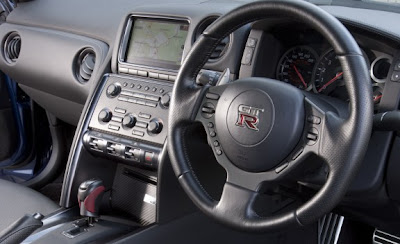Baca Juga

A freshened version of Nissan’s mighty GT-R is still about a month away from its official debut at the L.A. auto show, but Nissan went ahead and sent us some pictures of the U.S.-spec car. Unfortunately, we don’t have all of the specifics on the American version yet, but we have been able to glean plenty of info about the car from press releases distributed regarding the U.K.- and Japan-spec versions. Revised GT-Rs will arrive first elsewhere as 2011 models, whereas ours will go on sale in early 2011 as a 2012.
The photos confirm that the styling changes we observed at the recent Paris show will come here as well, including the revised front fascia with double “rectifier fins,” new LED running lights, and redesigned headlight innards, as well as new wheels, super-huge exhaust tips, and a revised rear diffuser. Both front and rear downforce measurements are said to increase by 10 percent compared to those of the current car, and Nissan also claims the overall coefficient of drag drops from 0.27 to 0.26, which is surprising since added downforce usually increases the drag coefficient.
More important to GT-R fans are the changes made to the twin-turbocharged 3.8-liter V-6, which deliver a healthy 38-hp boost (to 523), and a rise in torque from 434 to 451 lb-ft. Modifications were made in the areas of boost pressure, valve timing, air/fuel mixture, and exhaust flow. Nissan claims improvements in emissions and fuel economy as well.
Nissan made improvements to the six-speed dual-clutch transmission’s “R mode” launch control; we hope they will bring 0–60 times back down into the low threes. (The company chose to reprogram the system for 2010—slowing the car’s sprint by 0.6 second to 3.8 in the process—due to transmission reliability issues.) Also of interest is a two-wheel-drive mode that prevents low-speed binding in parking lots; it activates when the car is traveling at speeds below 6 mph and the steering wheel is turned more than halfway to full lock. We’d like to see a two-wheel-drive mode we could use on the track, too.
The GT-R’s structure has been strengthened with a new strut-tower brace and another brace added behind the glove box. Chassis tweaks include modifications to the front springs, shocks, and anti-roll bar; an increased front caster angle for improved straight-line stability; a lower rear roll center; and new front brake rotors said to improve fade resistance while extending rotor life.
Thanks to a redesigned dash pad with improved stitching and a new nav-display surround, among other minor revisions, the interior should appear a bit more worthy of the GT-R’s premium price, which is currently set at $85,060 for the 2011 model. Other markets will get numerous derivatives beyond the standard (Nissan calls it Pure) car described above, including Black, Premium, Spec V, and the over-the-top EGOIST and Club Track models. We’re not sure which of them we will get here, although we’re told the U.S. model lineup will be similar to today’s.

A freshened version of Nissan’s mighty GT-R is still about a month away from its official debut at the L.A. auto show, but Nissan went ahead and sent us some pictures of the U.S.-spec car. Unfortunately, we don’t have all of the specifics on the American version yet, but we have been able to glean plenty of info about the car from press releases distributed regarding the U.K.- and Japan-spec versions. Revised GT-Rs will arrive first elsewhere as 2011 models, whereas ours will go on sale in early 2011 as a 2012.
The photos confirm that the styling changes we observed at the recent Paris show will come here as well, including the revised front fascia with double “rectifier fins,” new LED running lights, and redesigned headlight innards, as well as new wheels, super-huge exhaust tips, and a revised rear diffuser. Both front and rear downforce measurements are said to increase by 10 percent compared to those of the current car, and Nissan also claims the overall coefficient of drag drops from 0.27 to 0.26, which is surprising since added downforce usually increases the drag coefficient.
More important to GT-R fans are the changes made to the twin-turbocharged 3.8-liter V-6, which deliver a healthy 38-hp boost (to 523), and a rise in torque from 434 to 451 lb-ft. Modifications were made in the areas of boost pressure, valve timing, air/fuel mixture, and exhaust flow. Nissan claims improvements in emissions and fuel economy as well.
Nissan made improvements to the six-speed dual-clutch transmission’s “R mode” launch control; we hope they will bring 0–60 times back down into the low threes. (The company chose to reprogram the system for 2010—slowing the car’s sprint by 0.6 second to 3.8 in the process—due to transmission reliability issues.) Also of interest is a two-wheel-drive mode that prevents low-speed binding in parking lots; it activates when the car is traveling at speeds below 6 mph and the steering wheel is turned more than halfway to full lock. We’d like to see a two-wheel-drive mode we could use on the track, too.
The GT-R’s structure has been strengthened with a new strut-tower brace and another brace added behind the glove box. Chassis tweaks include modifications to the front springs, shocks, and anti-roll bar; an increased front caster angle for improved straight-line stability; a lower rear roll center; and new front brake rotors said to improve fade resistance while extending rotor life.
Thanks to a redesigned dash pad with improved stitching and a new nav-display surround, among other minor revisions, the interior should appear a bit more worthy of the GT-R’s premium price, which is currently set at $85,060 for the 2011 model. Other markets will get numerous derivatives beyond the standard (Nissan calls it Pure) car described above, including Black, Premium, Spec V, and the over-the-top EGOIST and Club Track models. We’re not sure which of them we will get here, although we’re told the U.S. model lineup will be similar to today’s.













